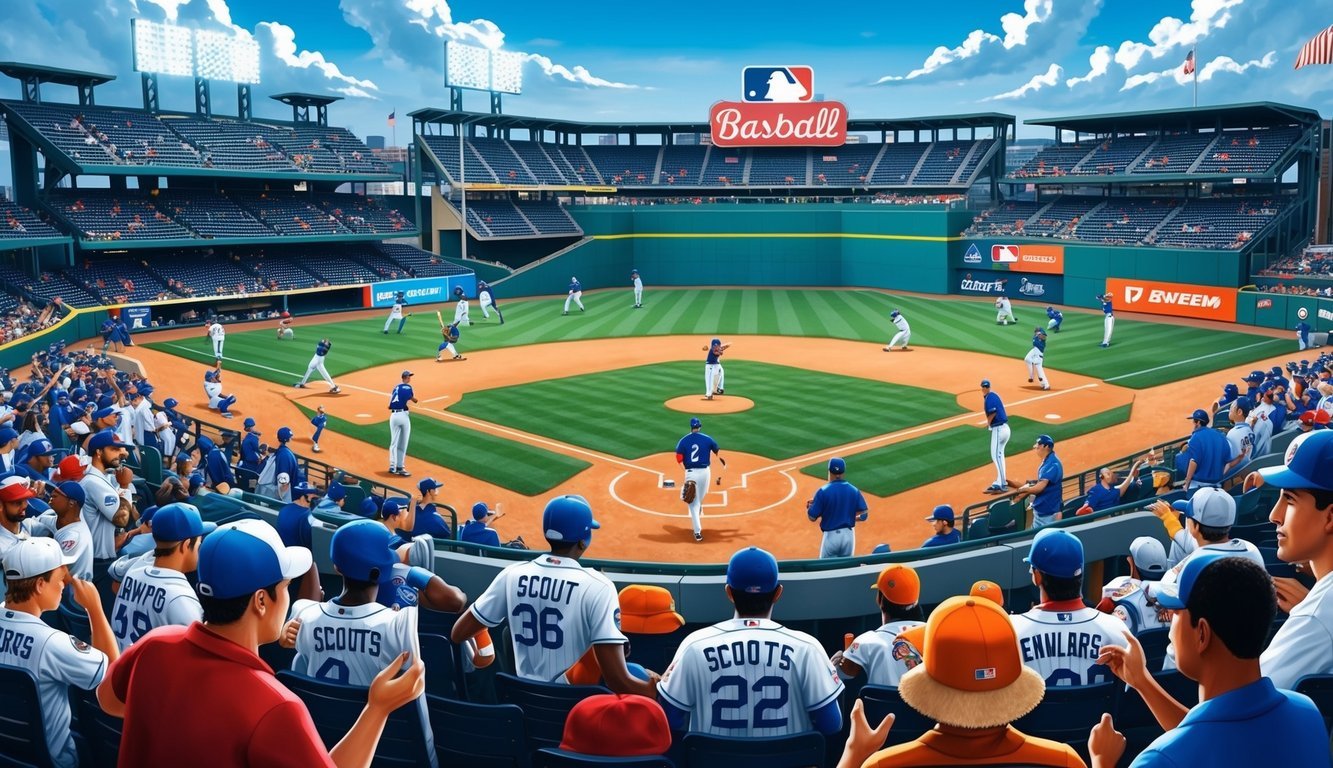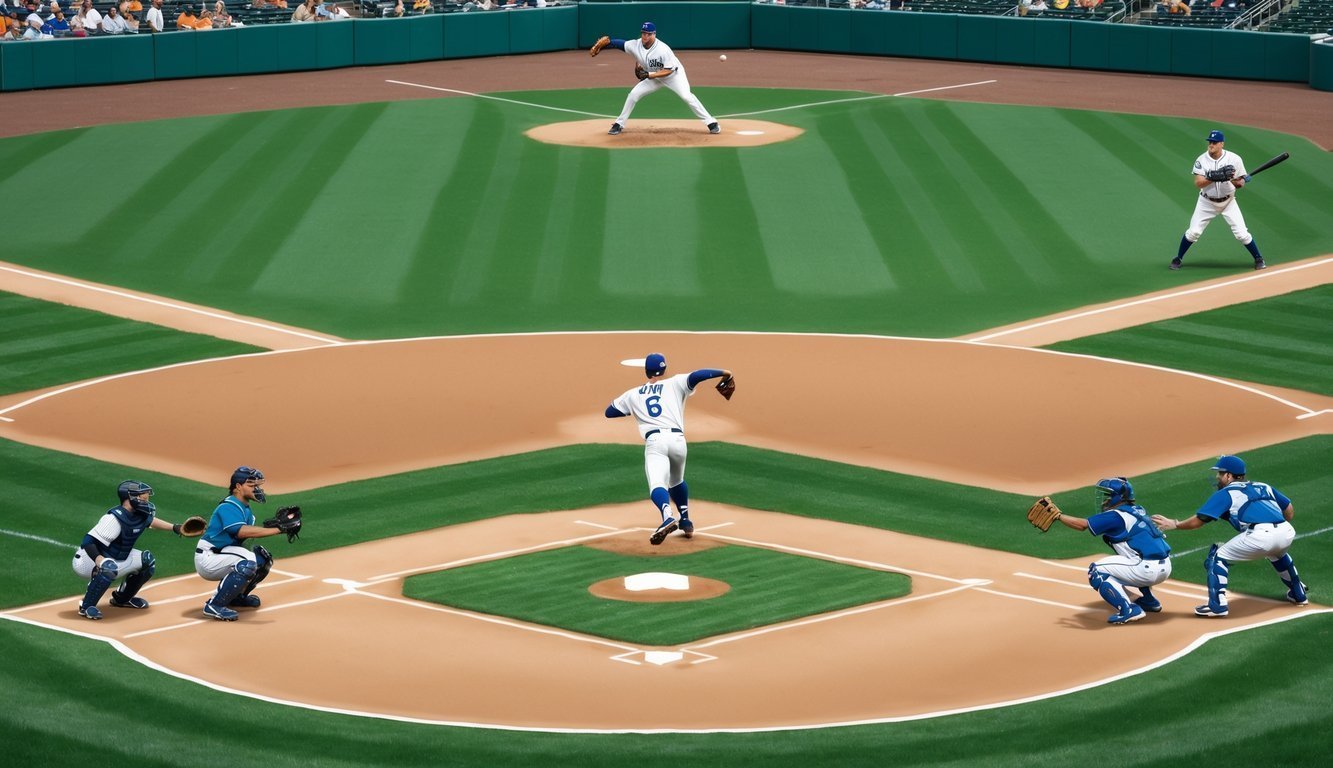Baseball isn’t just America’s pastime; it’s big business.
Major League Baseball generates billions in revenue annually through ticket sales, merchandise, media rights, and sponsorships.
The sport’s economic impact extends far beyond the diamond, creating jobs and boosting local economies.
MLB franchises are valuable assets, with the average team worth over $2 billion. Owners invest heavily in player talent, stadium upgrades, and marketing to maximize profits and grow their brand.
The league’s revenue sharing system aims to promote competitive balance, though small-market teams still face challenges competing financially with large-market powerhouses.
Players, too, have become savvy businessmen.
Top stars earn massive contracts and lucrative endorsement deals.
The MLB Players Association negotiates on behalf of players to ensure fair compensation and working conditions.
As the business of baseball evolves, balancing tradition with innovation remains key to the sport’s future success and popularity.
The Evolution of Major League Baseball
Major League Baseball’s journey from its humble beginnings to becoming America’s national pastime spans over a century.
The sport has undergone significant changes, expanding its reach and captivating fans across generations.
From Origins to the National Pastime
Baseball’s roots trace back to the mid-19th century.
The New York Knickerbocker Baseball Club, founded in 1845, played a crucial role in formalizing the game’s rules.
As baseball’s popularity grew, it spread across America, capturing the hearts of fans nationwide.
By the late 1800s, baseball had firmly established itself as the national pastime.
Professional leagues emerged, attracting talented players and drawing large crowds.
The sport’s growth reflected the nation’s rapid industrialization and urbanization.
Era of Expansion and the Creation of Leagues
The National League (NL) formed in 1876, marking a pivotal moment in baseball history.
It introduced a more organized structure to professional baseball.
The American League (AL) followed in 1901, creating healthy competition.
In 1903, the NL and AL came together to form Major League Baseball.
This merger set the stage for the modern era of professional baseball.
Over the decades, MLB expanded from 16 teams to 30, reaching new cities and fans across North America.
Milestones: World Series and All-Star Games
The first World Series in 1903 pitted the best teams from the NL and AL against each other.
This annual championship quickly became baseball’s pinnacle event, crowning the sport’s ultimate champion.
The All-Star Game debuted in 1933, showcasing the game’s top talent.
This mid-season classic brought together star players from both leagues, thrilling fans with exceptional displays of skill.
These marquee events helped cement baseball’s place in American culture.
They created lasting traditions, unforgettable moments, and legendary performances that continue to captivate fans today.
Economics of Baseball Clubs
Baseball clubs operate as complex businesses with diverse revenue streams and financial considerations.
Their economic models balance various factors to maintain profitability and competitiveness in the sport.
Understanding Revenue Streams
Baseball clubs generate income from multiple sources.
Ticket sales remain a crucial revenue stream, with pricing strategies tailored to maximize attendance and profits.
Concessions and merchandise sales at ballparks contribute significantly to a team’s bottom line.
Broadcasting rights for television and radio coverage provide substantial income.
Major League Baseball’s national TV contracts bring in billions of dollars, distributed among teams.
Local TV deals can be extremely lucrative for individual clubs.
Sponsorships and advertising partnerships offer another key revenue source.
Companies pay for stadium naming rights, signage, and promotional events.
Digital platforms and social media have opened new avenues for sponsorship deals and fan engagement.
Profit and Financial Management
Baseball clubs must balance their revenues against substantial expenses.
Player salaries often represent the largest cost, with top stars commanding multi-million dollar contracts.
Stadium operations, staff wages, and travel expenses add to the financial burden.
Effective financial management is crucial for long-term success.
Clubs invest in player development systems to nurture talent cost-effectively.
Smart contract negotiations and salary structures help teams remain competitive while controlling costs.
Revenue sharing among MLB teams aims to level the playing field between large and small market clubs.
This system redistributes income to promote league-wide financial stability and competitiveness.
The Impact of Television and Radio
TV and radio broadcasts have transformed baseball’s economics.
National networks pay billions for MLB broadcasting rights, providing a steady income stream for all teams.
Local TV deals can vary widely, with some large-market teams securing contracts worth over $100 million annually.
These lucrative deals have contributed to rising player salaries and increased team valuations.
They’ve also changed how fans consume baseball, with cable and streaming services offering new ways to watch games.
Radio broadcasts remain important, especially for building local fan bases.
While not as financially impactful as TV, radio rights still generate significant revenue for clubs and maintain baseball’s connection to its audio roots.
Player Market Dynamics

The economics of player talent shape Major League Baseball’s competitive landscape.
Teams strategically balance payroll constraints with the pursuit of top performers to build winning rosters.
Contracts and Salaries
MLB players earn substantial salaries through complex contract structures.
Top stars like Mike Trout command record-breaking deals, with his 12-year, $426.5 million contract setting a new benchmark.
Guaranteed contracts protect players from performance declines or injuries.
Teams offer varied contract lengths and values based on a player’s age, skill level, and market conditions.
Younger stars often receive long-term extensions to secure their services through prime years.
Veterans may sign shorter deals with higher annual values.
Salary arbitration allows players with 3-6 years of service time to negotiate pay increases based on performance comparisons.
The Reserve Clause and Free Agency
The reserve clause once bound players to teams indefinitely, limiting their negotiating power.
Its abolition in 1975 ushered in the free agency era, fundamentally altering baseball’s economic structure.
Free agency allows players with six years of MLB service to negotiate with any team.
This open market drives up salaries for top talents as clubs compete for their services.
The system creates classes of free agents:
- Unrestricted free agents (6+ years of service)
- Restricted free agents (3-6 years, subject to compensation)
- Minor league free agents
Role of the Players Association
The MLB Players Association advocates for players’ rights and financial interests.
Key responsibilities include:
- Negotiating the Collective Bargaining Agreement
- Representing players in salary arbitration
- Addressing grievances and disciplinary matters
- Overseeing licensing and marketing programs
The union’s efforts have secured vital benefits like:
- Minimum salaries
- Pension plans
- Travel accommodations
- Health insurance
MLBPA leadership engages in ongoing dialogue with MLB to address emerging issues affecting player welfare and compensation.
MLB Teams and Ownership

Major League Baseball teams are valuable assets with complex ownership structures.
The league’s 30 franchises are controlled by wealthy individuals, families, and corporations who shape the business of baseball through their decisions and investments.
Buying, Selling, and Relocating Teams
MLB franchises change hands occasionally, often for eye-popping sums.
The Los Angeles Dodgers sold for a record $2.15 billion in 2012.
More recently, Steve Cohen purchased the New York Mets for $2.4 billion in 2020.
Team relocations are rare but impactful.
The Montreal Expos moved to Washington D.C. in 2005, becoming the Nationals.
The Oakland Athletics are pursuing a move to Las Vegas, which would be MLB’s first relocation since 2005.
When teams go up for sale, they typically attract multiple bidders.
The process can be lengthy and involves MLB approval of new owners.
Owners and Their Influence
MLB team owners wield significant power in shaping the sport.
They make crucial decisions on player payrolls, stadium investments, and team operations.
Some owners, like the New York Yankees’ Steinbrenner family, are known for lavish spending on star players.
Others, like Stuart Sternberg of the Tampa Bay Rays, have found success with smaller budgets and analytics-driven approaches.
Owners also play key roles in league-wide issues like labor negotiations and rule changes.
The Toronto Blue Jays are unique as one of three MLB teams owned by a corporation rather than individuals or families.
Forbes Valuations and Business Strategy
Forbes magazine publishes annual valuations of MLB franchises, offering insights into baseball’s business landscape.
The New York Yankees consistently top the list, valued at $6 billion in 2023.
Team values have skyrocketed in recent years, driven by lucrative TV deals and rising ticket prices.
Even smaller-market teams are now worth over $1 billion.
Owners employ various strategies to boost their team’s value and profitability.
Some focus on winning at all costs, while others prioritize financial efficiency.
Many have invested in stadium upgrades or new ballparks to enhance revenue streams.
Spotlight on the Future

Baseball’s future shines bright with technological advancements, minor league developments, and evolving business strategies.
The sport faces both challenges and opportunities as it aims to captivate new generations of fans and players.
Emerging Technologies and Baseball
Virtual reality (VR) is transforming how fans experience the game.
Teams are experimenting with VR applications that allow viewers to feel like they’re on the field.
This immersive technology could revolutionize at-home viewing.
Data analytics continue to shape team strategies.
Advanced spreadsheets help managers make informed decisions about lineups and pitching rotations.
Some clubs are even using AI to predict player performance and injury risks.
Wearable tech is gaining traction too.
Smart devices monitor players’ health and performance, providing valuable insights to trainers and coaches.
These innovations could lead to longer careers and fewer injuries.
The Minor League’s Role in Growth
Minor league baseball remains crucial for talent development and fan engagement.
These smaller venues often serve as testing grounds for new ideas in fan experience and community outreach.
Many minor league teams are focusing on creating unique, family-friendly environments.
Theme nights, interactive games, and local partnerships help draw crowds and build lasting connections.
The Business of Baseball Committee is working to strengthen ties between major and minor league operations.
This collaboration aims to create a more unified baseball ecosystem, benefiting players and fans alike.
Challenges and Opportunities Ahead
Baseball faces the ongoing challenge of attracting younger audiences.
Social media and digital platforms offer new ways to connect with fans.
However, the sport must balance tradition with innovation.
Leagues and teams are increasingly leveraging streaming services and interactive content to engage a tech-savvy generation.
At the same time, they must ensure that affiliate and advertising disclosures are clear and transparent when partnering with brands and digital platforms.
By embracing new media while staying true to the game’s heritage, baseball can cultivate a fresh fan base without alienating longtime supporters.
Recent scandals have tested public trust in the game.
Team owners and league officials are working to implement stricter policies.
They also aim to increase transparency to maintain the sport’s integrity.
Climate change poses a threat to the traditional baseball calendar.
Extreme weather events could impact spring training.
They could also potentially shift the timing of Opening Day in future seasons.
International expansion presents exciting opportunities.
MLB is exploring new markets abroad.
This could potentially lead to a truly global World Series in the coming decades.
